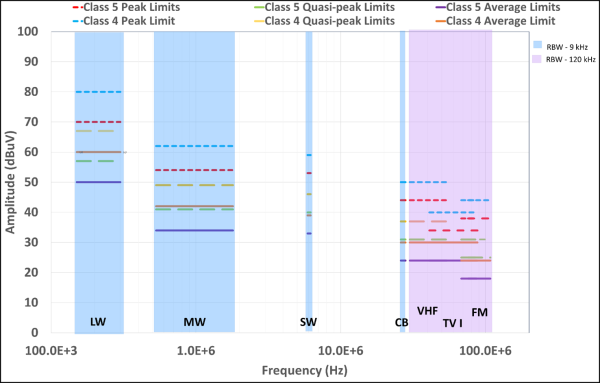Electromagnetic interference (EMI) remains a significant design challenge, especially in automotive power converters. CISPR 25 is a stringent standard for radiated emissions in automotive applications. It defines limits for components and whole vehicles, using quasi-peak and average detectors across a wide frequency range. Measurements are conducted in the vicinity closer to the device under testing, compared to other standards, ensuring compatibility with various radio services. To ensure compliance with stringent regulations, designers must carefully consider the sources and types of EMI. The general test requirements are:
Figure 1 shows the limits of Class 5 (Peak, Quasi-peak, and Average) and Class 4 (Peak, Quasi-peak, and Average) at various frequency ranges. Table 1 shows the limits of disturbances at various frequency ranges and various classes from 5 to 1 in more detail.

Figure 1: Graphical Limits of CISPR 25 Class 5 and Class 4
Table 1: Limits of CISPR 25 Disturbances
Diodes Incorporated (Diodes) offers innovative solutions that address stringent CISPR 25 Class 5 or 4 standards for automotive applications, and we have released hardware boards with DC-DC (listed in the table below) and Reverse Voltage protection using the AP74700Q.
|
Component |
EVM Board |
Input Voltage Range (V) |
Output Voltage Range (V) |
Current Rating (A) |
Conducted EMC Compliance |
Radiated EMC Compliance |
|
3.8-60 |
0.8-40 |
3 |
Class 5 |
Class 5 |
||
|
3.8-40 |
0.8-Vin |
1 |
Class 5 |
Class 5 |
||
|
3.8-40 |
0.8-Vin |
2 |
Class 5 |
Class 5 |
||
|
3.8-40 |
0.8-Vin |
3.5 |
Class 5 |
Class 5 |
||
|
3.8-40 |
0.8-Vin |
5 |
Class 5 |
Class 5 |
| Reference Designs / EVBs for CISPR 25 | Design Files |
| AL8891Q-EV1 User Guide | AL8891Q-EV1 Design Files |
| AP64xxx-SO8P CISPR25 User-Guide | DDB108R2 Design Files |
| AP66xx0/AP64xx3Q-QFN4040 CISPR25 User-Guide | DDB103R3 Design Files |
| AP74700Q 10A CISPR25 User-Guide | DDB106R1 Design Files |
| AP74700Q 40A CISPR25 User-Guide | DDB104R3 Design Files |
| AP74700Q 55A CISPR25 User-Guide | DDB107R1 Design Files |
| AP68255Q/AP68355Q/AP6A255Q/AP6A355Q | DDB115R1 Design Files |
Related Devices:
Application Notes:
Blogs/Tech Articles